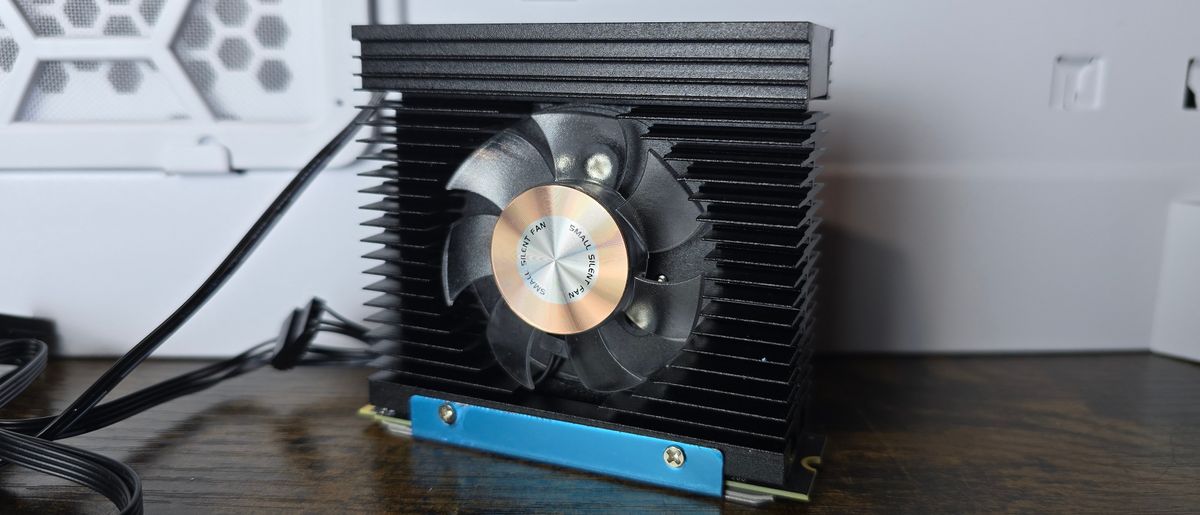Tom's Hardware Verdict
iHTP’s M.2 SSD Cooler delivers the strongest performance we’ve tested, at a budget-tier price of only $6.99.
Pros
- +
Industry-leading thermal performance
- +
Broad compatibility with air coolers
- +
Low cost of only $6.99
Cons
- -
May not be compatible with the widest air coolers
Why you can trust Tom's Hardware
It has been a while since I’ve tested SSD heatsinks, but recently I saw iHTP’s m.2 2280 NVMe cooler on Amazon for only $6.99 and at first glance it looked rather impressive – so I impulse bought it for testing.
Now who is iHTP? That’s a good question. There’s not much information about the company to be found online, and looking at NewEgg’s store (see Newegg promo codes) it appears the company is selling rebranded DeepCool products under its name. That raises eyebrows to say the least, as it’s probably a violation of U.S. sanctions – and this wouldn’t be the first time a retailer has attempted to sell rebranded DeepCool products.
While some of its other products might be questionable, I’m glad I bought iHTP’s SSD heatsink - because the looks weren’t deceptive – this is one of the best SSD heatsinks I’ve ever tested!
For this heatsink review, I’ve done things a little differently than before. Thermal tests have been performed with both air and liquid coolers, and I’ve run two sets of tests on each system. Let’s take a quick look at the unit’s specifications and features, then we’ll take a look at a few thermal results.
Cooler specifications
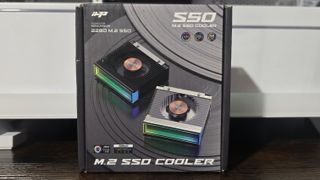
| Cooler | iHTP M.2 SSD Cooler |
| MSRP | $6.99 USD |
| Radiator Material | Aluminum |
| Fan Speed | Up to 4000RPM |
| Lighting | ARGB on fans |
| Warranty | Unknown, but at $6.99 who cares? |
Packing and included contents
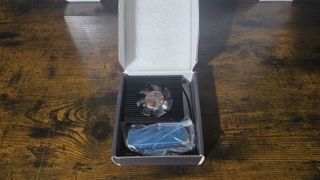
The packaging is fairly simple, with the cooler arriving in a small box just large enough to contain the product. Included in the box are the heatsink and fan, base, two thermal pads, and necessary screws.
Features of iHTP’s M.2 SSD Cooler
Tall, but thin design with an integrated fan
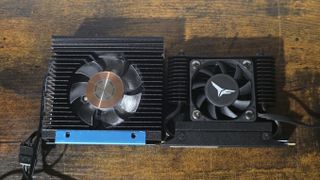
iHTP’s SSD heatsink features a tall but thin design with a fan integrated into the heatsink. This can be useful for tight environments that have a lot of heat – for example, if your SSD is next to a GPU. To give an idea of its size, the picture above shows the iHTP heatsink (left) next to TeamGroup’s Dark Airflow I (right).
Broad compatibility with air coolers
Some of the strongest SSD coolers on the market are not compatible with air coolers due to their size. While I can’t guarantee the iHTP will be compatible with every air cooler on the market, it will fit well with many setups. For today’s results with air cooling, I’ve paired this SSD heatsink with Scythe’s Mugen 6. While spacing is tight in this setup, it fits without a problem.
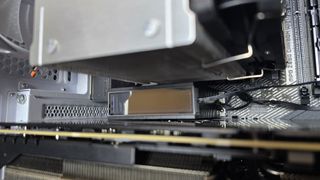
aRGB lighting with infinity mirror
While I don’t see the need for bling on a product like this, some of y’all like to have lighting. If that describes you, you’ll be happy to know that the cooler features optional ARGB lighting and an infinity mirror design.
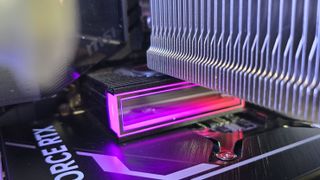
Testing configuration and methodology – LGA1851 platform
When I first started testing heatsinks, I used an i7-13700K system that was limited to PCIe 4.0 in an attempt to try to explain how these types of products might be useful even if you’re not using a PCIe 5.0 SSD.
With today’s review, we’re moving on to a PCIe 5.0 Platform using Intel’s “Arrow Lake” Core Ultra 7 265K – and these benchmarks will be a bit more in-depth than previous reviews. To start, tests are performed using both liquid and air coolers to see how that can impact performance. Additionally, in addition to a standard stress test, I’ve implemented another stress test that runs concurrently to a GPU stress test – to see how the cooler fares when there are multiple sources of heat in the case to combat.
| CPU | Intel Core Ultra 7 265K | Row 0 - Cell 2 |
| GPU | MSI Ventus 3X RTX 4070Ti Super | Row 1 - Cell 2 |
| Motherboard | MSI Z890 Carbon Wifi | Row 2 - Cell 2 |
| Case | MSI MPG Velox 100R | Row 3 - Cell 2 |
| System fans | Pre-installed case fans | Row 4 - Cell 2 |
| SSD | TeamGroup Z540 PCI-e 5 SSD | Row 5 - Cell 2 |
| Air Cooler | Scythe Mugen 6 | Row 6 - Cell 2 |
| Liquid AIO Cooler | Tryx Panorama 240 | Row 7 - Cell 2 |
Heatsink Installation
The installation of the SSD cooler is simple, and if you’ve seen one you’ve basically seen them all – there’s very little variance in installation procedures due to the similarities of these units.
1. Take the base of the unit and apply the first thermal pad.

2. Place your SSD on top of the first thermal pad, and then place the second thermal pad on top of it.
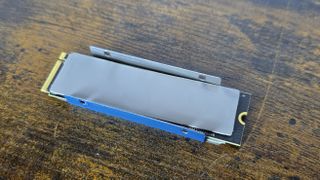
3. Place the heatsink above the top thermal pad, and then secure it with the included screws.
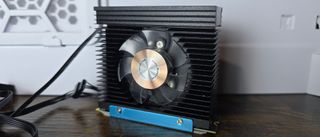
4. Finally, place the unit into an M.2 slot on your motherboard and then connect the ARGB and PWM cables. I’ve installed it in the slot between my GPU and CPU cooler here, but you may need to use another slot if you have a particularly wide air cooler.
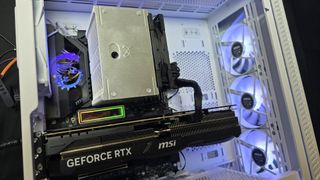
Stress test thermal results with Air Cooling
When I first started publishing SSD heatsink reviews, I limited my testing to a system that incorporated an AIO liquid cooler. This type of testing was useful, but didn’t quite tell the whole story – because many users will opt for air cooling instead. Our first round of results here were benchmarked while cooling the CPU with Scythe’s Mugen 6 air cooler.
Now this review doesn’t have as many comparative results as prior reviews, but I’ve included the best heatsink I’ve previously tested – TeamGroup’s Dark Airflow I – and a few heatsinks that aren’t quite as strong. The heatsinks I’ve tested the iHTP against were chosen carefully, and I believe this review will have just enough information to cover everything you need to know about iHTP’s NVMe SSD cooler.
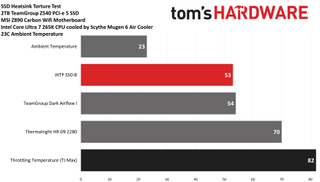
This first thermal test is done while running a custom IOMeter script designed to stress both the NAND and the SSD’s Phison E26 controller. iHTP’s heatsink solution was surprisingly strong despite its budget price of only $6.99, taking the crown from TeamGroup for the strongest-performing SSD heatsink I’ve tested.
But honestly, devices like this are going to be most useful in environments that have a lot of heat density – like servers. So to increase the difficulty of testing, I’ve run a second stress test on the SSD while also running a stress test on my GPU, which adds an additional 290W of heat to the system.
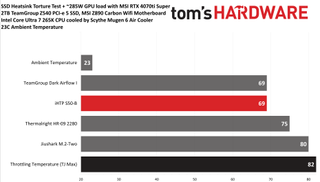
In this more intensive scenario, temperatures rise 16 degrees Celsius. The iHTP cooler doesn’t outperform TeamGroup’s Dark Airflow I in this more difficult test, but it does share the crown for the best performance of any SSD heatsink I’ve tested!
Stress test thermal results with liquid cooling
For testing these heatsinks with a liquid cooler, I’ve used Tryx Panorama 240 AIO. Tests performed are the same as above, the only difference being the use of an AIO instead of an air cooler.
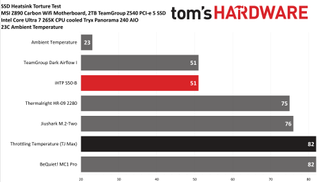
Using an AIO to cool the CPU, iHTP’s S50-B shares the crown with TeamGroup’s Dark Airflow I in this SSD stress test. For $6.99, this is an especially impressive result given that the TeamGroup cooler was $35 when we tested it (and currently hard to find in stock).
How’s performance when you increase the thermal difficulty by also running a stress test on the GPU to simulate a server-like environment with multiple sources of heat?
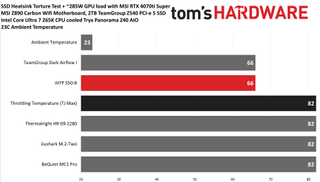
iHTP’s cooler performs very well even when the heat of a GPU is added to the equation – on par with TeamGroup’s Dark Airflow I, tying for the best thermal results of any SSD heatsink I’ve tested.
The increased temperature with a GPU load on a liquid cooling setup is about the same as with air cooling for the iHTP and TeamGroup coolers, but with slightly lower temperatures - 66c with Tryx Panorama 240 AIO vs 69c with Scythe’s Mugen 6.
It’s interesting to observe that weaker heatsinks from Thermalright and Jiushark aren’t able to keep the SSD from throttling while paired with an AIO, while they were able to pass this test when configured with an air cooler due to the airflow such a setup provides.
Conclusion
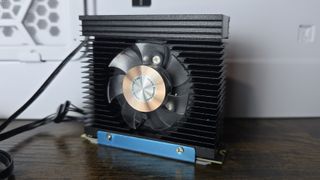
iHTP’s SSD heatsink provides industry-leading thermal performance while having a rock-bottom price of only $6.99 at Amazon. If you’re looking for an SSD heatsink with a little bit of bling and top cooling performance, iHTP’s slim SSD tower is what you’re looking for!

Albert Thomas is a contributor for Tom’s Hardware, primarily covering CPU cooling reviews.
-
dwd999 For those of us who are not into useless lights, are you saying that the ARGB portion of the cooler is not removable?Reply -
thestryker Pricing is likely weird due to limited stock and it being sold out.Reply
I'm not totally sold on using a M.2 cooler with fan, but if you were using an AIO it should also add minor airflow over the socket for the bigger ones like this.
I know it would just add to the work, but I wonder if one of the AIOs with a fan on the block would move air enough to help with the passive SSD cooling. Though I suppose if Arctic sent you their offset LGA 1851 mount it'd be a good excuse to pull one of the LFIIIs out and then test this as well. -
Albert.Thomas Reply
I'm not sure what's going on for sure, I am not smart enough to understand.Joel02 said:The price is showing up as $22.10 on your Amazon link.
But I have to wonder if it has anything to do with the comments I made about iHTP possibly being a front for DeepCool to illegally sell their products in the USA under a different brand name.
Only time will tell. -
Albert.Thomas Reply
Please remind me to double check tomorrow. I'm going to bed now.dwd999 said:For those of us who are not into useless lights, are you saying that the ARGB portion of the cooler is not removable? -
Notton I don't understand how that works so well considering it doesn't use a heatpipe, and it's stretching the limits of aluminum heat transfer speed.Reply
I'd love to see a FLIR shot of it. -
dwd999 Reply
Today??Albert.Thomas said:Please remind me to double check tomorrow. I'm going to bed now. -
Albert.Thomas Reply
I took a closer look at it. The top infinity mirror does not seem to be easily removable.dwd999 said:For those of us who are not into useless lights, are you saying that the ARGB portion of the cooler is not removable? -
m3city Why no transfer tests? At least synthetc ones, but naturally a more real life test eg game loading, copy-paste of several gb file and few thousands of smaller files. I dont care if it gets hot. I would not care if file operations are a little bit longer - depending on how much. And thats the thing not tested/shown here. So the test is generally useless.Reply -
Albert.Thomas Reply
These tests are designed to determine which of these products have the best thermal dissapation. Unless they fail my tests and throttle, there should be little variance in actual performance for most users. With these higher end heatsinks, a common user is not going to notice a performance difference.m3city said:Why no transfer tests? At least synthetc ones, but naturally a more real life test eg game loading, copy-paste of several gb file and few thousands of smaller files. I dont care if it gets hot. I would not care if file operations are a little bit longer - depending on how much. And thats the thing not tested/shown here. So the test is generally useless.
I hope this helps you.
